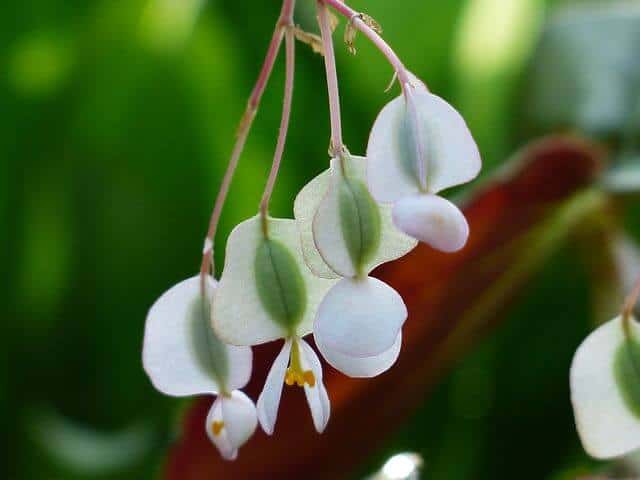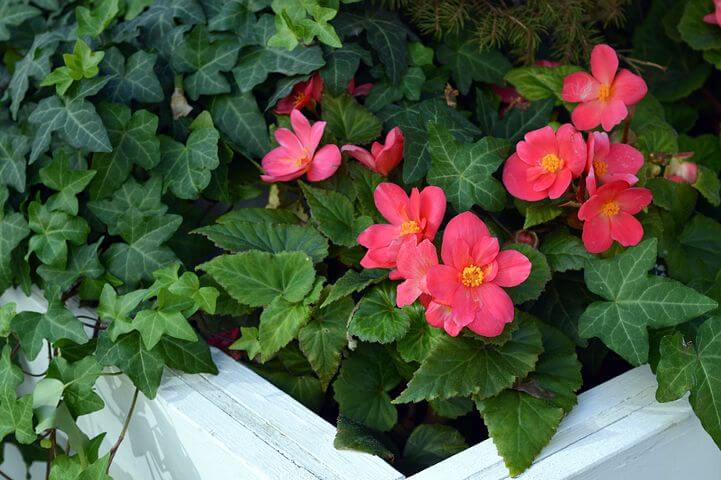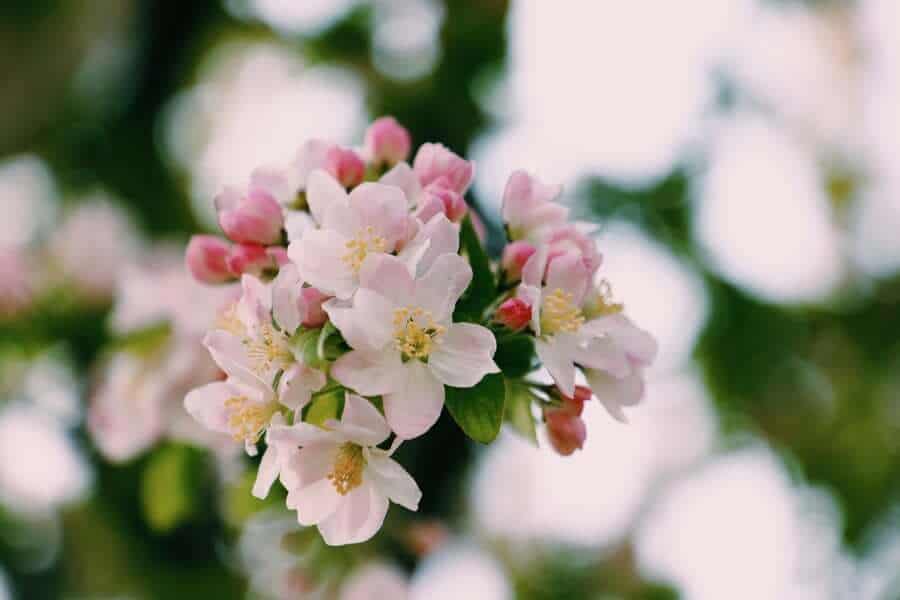Last Updated on January 8, 2023 by a Friendly Gardener
This type of begonia is most likely the easiest of its kind to recognize for houseplant lovers. It is a cane-type of begonia that is simple to cultivate. The Angel Wing Begonia belongs to the Begoniaceae family. It is a perennial shrub that finds its native habitat in Brazil. Botanically, it is referred to as the begonia aconitifolia x begonia coccinea. Begonia lovers can thank Eva Kenworthy Gray’s home hybridizing efforts in 1926 in California.
The Begonia family includes more than 1500 species. Among these, the Angel Wing Begonia, in particular, has been extensively hybridized, meaning that hundreds of hybrids exist. Long jointed stems characterize this plant and foliage and blooms grow directly from these joints. Large angel wing-shaped leaves in a deep dark green hue are sprinkled with silver. Leaf undersides will be a vibrant red.
The Angel Wing begonia can become a rather large plant, so staking canes is recommended to protect the plant from damage. How vivid the bloom color will be determined by how much light a begonia has access to. An Angel Wing Begonia can remain a small table plant or grow to a shrub as much as five feet in height. Blooms grow in clusters and can be found in shades of orange, pink, and red as well as white.
Angel Wings Begonia Care

Soil
Angel Wing Begonias can be cultivated successfully in potting soil enriched with organic matter. The soil bed needs to remain moist without becoming water-logged or soggy. Avoid planting your begonia in a plastic flowerpot and opt instead for terracotta. Terracotta or clay pots aid in the evaporation of excess moisture.
African Violet soil mix is also a viable alternative to potting soil. You can choose to cultivate your Begonia in a soilless medium as long as it has been enriched with organic matter.
Light
The Angel Wing Begonia prefers year-round bright indirect light. While they are not as sensitive as other begonias and many other houseplants, they do not tolerate direct sunlight exposure. Bright indirect light is essential during cultivation if you hope for a more vivid leaf and bloom color. If you are more interested in the Angel Wing Begonia’s foliage, select a shaded location. It will not flower in the shade. Keep in mind that if the light is too strong, leaves will turn brown.
Water
Angel Wing Begonia plants need consistently moist soil beds. Flowerpots need a sufficient number of drainage holes. T soil’s top inch should be dry to the touch before you water your plant. To ensure the correct amount of water, soak your plant and let it drain entirely before placing it back in its spot. If you overwater, expect the leaves to yellow.
Humidity

Angel Wing Begonias love humidity. If you have a nice spot in a humid room like your bathroom or kitchen, your plant will thrive. If the area where you live is arid, or due to central air-conditioning or heating, your home or office has especially dry air, use a space humidifier.
Other options to increase humidity include
- Insert a pebble tray beneath the plant. Fill a tray with pretty stones and water. Set your plant above the waterline onto the tray.
- placing a small water-filled bowl in the vicinity of the plant.
- grouping plants together to create a microclimate. The various plants’ transpiration will raise the humidity level.
It is preferable to soak this plant or allow the plants to absorb water from underneath the pot. Wet foliage can cause Powdery Mildew or Leaf Spot Disease. It is recommended that you avoid wetting leaves when watering for this reason.
Temperature
Indoor temperatures for Angel Wing Begonias should be moderate and measure between 65° and 75° Fahrenheit. Exposure to temperatures of 50° F or below can harm the plant. Angel Wing Begonias also need to be protected from drafts, so avoid windows, doorways, hallways, and air conditioning units and vents when choosing a spot.
Feeding

Feed your Angel Wing Begonia with a liquid fertilizer at half-strength with an NPK of 10-10-10 bi-weekly. At the end of winter or early spring, as the flowering season starts, use a liquid fertilizer higher in phosphorous. This will encourage blooming. If you are cultivating your begonia for its striking foliage, use a fertilizer with more nitrogen. Apply fertilizer to moist soil to protect your plant from leaf burn.
Pruning
The Angel Wing Begonia tends to become leggy in improper environmental conditions. Pruning will prevent them from becoming floppy and encourage bushier growth. Prune just below a cane joint when necessary. Use the cuttings for propagation. Poles, stakes, trellises, and other kinds of support will aid in maintaining longer canes upright despite foliage weight.
Potting and Repotting
Fortunately, the Angel Wing Begonia likes being slightly root-bound. Repot your Angel Wing Begonia annually in the spring when new growth appears. When repotting, use a container that is one size larger than the current pot. Do not repot your Angel Wing Begonia if it is flowering.
Angel Wing Begonia Problems

The Angel Wing Begonia is at risk for houseplant pest infestations like aphids, whiteflies, mealybugs, and spider mites. If you see evidence of an insect infestation, isolate your plant and apply an insecticidal soap, or Neem oil which is an organic insecticide. Repeat the application until pests disappear.
Leaf Spot Disease will require the application of a fungicide. Neem oil also works as a fungicide. An alternative is mixing two teaspoons of mineral oil with a tablespoon of baking soda. Put the blended mixture in a spray bottle. Shake vigorously, blending well, and spray the whole plant.
The Angel Wing Begonia and Pets

Begonias, unfortunately, are toxic to both cats and dogs. These plants contain soluble calcium oxalates. Begonia poisoning symptoms include vomiting or exaggerated salivation. If you suspect your pet has chewed or eaten a piece of begonia, contact the local poison control center or your veterinarian immediately.
Angel Wing Begonia Propagation
The easiest way to propagate the Angel Wing Begonia is with stem cuttings. In the spring when new growth begins, snip a leaf-tip cutting between four and eight inches long. Make sure it has no blooms.
Insert the cut end of the stem segment into the growing medium. Moisten the soil and place the cutting in a warm spot until new growth appears. You can use rooting hormone to better your chances of the stem cutting developing roots. Dip the cut end in growth hormone before placing it in the soil.
Types of Angel Wing Begonias

While there are numerous hybrids, here are 5 popular varieties to consider:
- Anna Christine Angel Wing Begonias feature bright red flowers. While shorter than other varieties, it can grow to four feet.
- Looking Glass Angel Wing Begonias have silvery-hued foliage with prominent green veins. Blooms will be light pink in color.
- Charles Jaros Angel Wing Begonias will develop pink blossoms and reach an approximate height of eighteen inches.
- Silver Wings Angel Wing Begonias feature medium green-colored foliage with silver spots.
- Splish Splash Angel Wing Begonias boast large green leaves with white splashes. It develops both magenta and deeper pink blossoms.
The Angel Wing Begonia is a delightful plant that will brighten your home or office. It is easy to care for if the proper environmental conditions are assured including bright indirect light, moderate temperatures, sufficient humidity, and necessary pruning.

